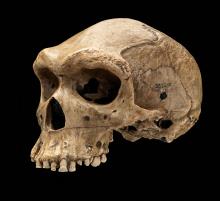Heidelberg 2-2
H heidelbergensis
- Erect Man of heidelberg
- 0.6 to0.3 mya
- Transition between homo erectus and neanderthal. Phylogeny. Meyer, 2016 studied genetic analysis of Sima de los huesos fossils and argue that it should be included in neanderthal lineage as archaic or early neanderthal. Intermediate between erectus and Neanderthal.
- Mauer jaw 1907 Shoetensack
- Subspecies. H heidelbergensis heidelbergensis, H h daliensis, H h rhodesiensis, H h steinheimensis.
- Geographical spread in Europe east and South Africa. Atapeurca, Sima de los huesos, Terra Amata, Steinheim in Europe. Kabwe, Zambia. Rabat, Sale, iLret in Africa.
- Features
- 1250 cc. 5.5 ft height. 55kg weight.
- Massive jaw. Breadth more than modern man
- Teeth similar to Homo sapiens
- Normal incisors and conines don't project
- No diastema
- Angle of the jaw is truncated and meeting place of two sides of mandible is very thick like apes.
This early human species had a very large browridge, and a larger braincase and flatter face than older early human species. It was the first early human species to live in colder climates; their short, wide bodies were likely an adaptation to conserving heat. It lived at the time of the oldest definite control of fire and use of wooden spears, and it was the first early human species to routinely hunt large animals. This early human also broke new ground; it was the first species to build shelters, creating simple dwellings out of wood and rock.
HTML Content
Year of Discovery: 1908
HTML Content
History of Discovery:
In 1908 near Heidelberg, Germany, a workman found the type specimen of H. heidelbergensis in the Rösch sandpit just north of the village of Mauer. This mandible was nearly complete except for the missing premolars and first two left molars; it is heavily built and lacks a chin. German scientist Otto Schoentensack was the first to describe the specimen and proposed the species name Homo heidelbergensis.
Before the naming of this species, scientists referred to early human fossils showing traits similar to both Homo erectus and modern humans as ‘archaic’ Homo sapiens.
HTML Content
Height: Males: average 5 ft 9 in (175 cm); Females: average 5 ft 2 in (157 cm)
HTML Content
Weight: Males: average 136 lbs (62 kg); Females: average 112 lbs (51 kg)
HTML Content
